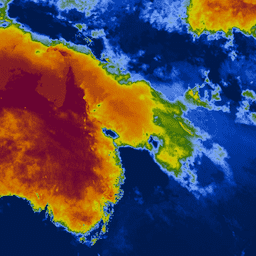
- 데이터 세트 제공
- 2007-01-01T00:00:00Z–2025-12-31T00:00:00Z
- 데이터 세트 제공업체
- 일본 도쿄대학교 산업과학연구소
- 주기
- 1일
- 태그
설명
Keetch-Byram 가뭄 지수 (KBDI)는 토양 및 부식층의 건조도를 추정하기 위한 연속 참조 척도입니다. 비가 오지 않는 날마다 지수가 증가하며 (증가량은 일일 최고 기온에 따라 다름) 비가 오면 감소합니다. 이 시스템은 주로 최근 강우 패턴을 기반으로 합니다. 기상학적 가뭄을 측정하는 지표로, 토양 내 수분 증가 또는 감소를 반영합니다.
범위는 0 (수분 부족 없음)에서 800 (극심한 가뭄)까지입니다. 지수의 범위는 식물이 쉽게 이용할 수 있는 포화 토양에 20cm의 수분이 있다고 가정하여 결정됩니다 (Keetch and Byram, 1968). KBDI는 국가 기상 예보, 산불 방지, 특히 강수량에 의존하는 작물이 있는 지역에서 유용하게 사용되는 가뭄 모니터링에 전 세계적으로 사용됩니다.
대역
픽셀 크기
4,000미터
대역
| 이름 | 최소 | 최대 | 픽셀 크기 | 설명 |
|---|---|---|---|---|
KBDI |
0 | 800 | 미터 | Keetch-Byram 가뭄 지수 |
이용약관
이용약관
인용
인용:
Wataru Takeuchi, Soni Darmawan, Rizatus Shofiyati, Mai Van Khiem, Kyaw San Oo, Uday Pimple and Suthy Heng, 2015. 아시아 농경지의 거의 실시간 기상학적 가뭄 모니터링 및 조기 경보 시스템 36th Asian conference on remote sensing (ACRS): Manila, Philippines, Oct. 20, 2015.
Earth Engine으로 탐색
코드 편집기(JavaScript)
var collection = ee.ImageCollection('UTOKYO/WTLAB/KBDI/v1') .select('KBDI') .filterDate('2019-01-01', '2019-01-10'); var bandViz = { min: 0, max: 800, palette: [ '001a4d', '003cb3', '80aaff', '336600', 'cccc00', 'cc9900', 'cc6600', '660033' ] }; Map.addLayer(collection.mean(), bandViz, 'Keetch-Byram Drought Index'); Map.setCenter(120, 3, 3);
